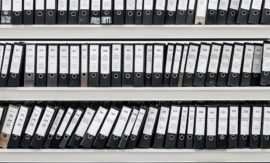Intended learning outcomes: Differentiate between the single-level bill of material, the multilevel bill of material, and the summarized bill of material.
Continuation from previous subsection (17.2.3a).
A single-level bill of material shows all the components of a product.
Figure 17.2.3.3 shows the three single-level bills of material, each with two bill-of-material positions, as implicitly defined by the example in Figure 1.2.2.2.
Fig. 17.2.3.3 Single-level bills of material.
The multilevel bill of material or indented bill of material shows the structured composition of a product, across all the levels.
Figure 17.2.3.4 shows the indented bill of material for the example in Figure 1.2.2.2.
Fig. 17.2.3.4 Indented bill of material (multilevel bill of material).
In this form, the content corresponds exactly to the graphical representation of a product as a tree structure, again as shown in Figure 1.2.2.2.[note 1703] The quantity per is always the cumulative quantity of the component used at this point in the product (by way of contrast to the graphical form in Figure 1.2.2.2).[note 1704] An algorithm can also be used to generate a multilevel bill of material from the single-level bills of material.
The summarized bill of material is a condensed multilevel bill of material in which each component occurs only once, although the total quantity per is specified.
Figure 17.2.3.5 shows the summarized bill of material for the example in Figure 1.2.2.2.
Fig. 17.2.3.5 Summarized bill of material (condensed multilevel bill of material).
The quantity per is the cumulative quantity of components used in the product. A summarized bill of material is used for manual cost estimation or for quickly calculating the number of components to be bought for a lot of end products. A summarized bill of material can also be generated from the single-level bills of material using an algorithm.
Continuation in next subsection (17.2.3c).
Course section 17.2: Subsections and their intended learning outcomes

17.2 The Master Data for Products and Processes
Intended learning outcomes: Describe master data of products, components, and operations. Explain the data structure of item master, bill of material, and where-used list. Disclose the data structure of work center master data, the work center hierarchy, as well as for operation, routing sheet, production equipment, bill of production equipment, and bill of tools.

17.2.1 Product, Product Structure, Components, and Operations
Intended learning outcomes: Present the concept of master data. Explain the production order as a collection of master data. Describe a simple product structure.

17.2.1b The Intermediate Part
Intended learning outcomes: Identify the intermediate part used simultaneously as a component in higher-level products.

17.2.2 Item Master Data
Intended learning outcomes: Present the concept of the item master record. Describe the attributes of the technical information and the stockkeeping information of the item master record. Identify attributes of the item master record for information on costs and prices.

17.2.3a Bill of Material, Bill-of-Material Position, and Where-Used List
Intended learning outcomes: Present the concepts of the bill of material, of the bill-of-material position, and the where-used list.

17.2.3b Single-Level Bill of Material, Multilevel Bill of Material, and Summarized Bill of Material
Intended learning outcomes: Differentiate between the single-level bill of material, the multilevel bill of material, and the summarized bill of material.

17.2.3c Single-Level Where-Used List, Multilevel Where-Used List, and Summarized Where-Used List
Intended learning outcomes: Differentiate between the single-level where-used list, the multilevel where-used list, and the summarized where-used list.

17.2.3d The Bill-of-Material Position and the Where-Used-List Position as a Logistical Object
Describe the bill-of-material position and the where-used-list position as logistical objects. Identify its most important attributes.

17.2.4 Work Center Master Data
Intended learning outcomes: Present the work-center business object. Describe the attributes of the work-center master record relating to capacity, concerning costs, and for calculating the lead time.

17.2.5 The Work Center Hierarchy
Intended learning outcomes: Present the concepts of workstation and cost center. Explain the work center hierarchy.

17.2.6 Operation and Routing Sheet
Intended learning outcomes: Present the operation business object in association with the routing sheet. Describe its attributes. Identify the work center where-used list.

17.2.7 Production Equipment, Bill of Production Equipment, and Bill of Tools
Intended learning outcomes: Present the concepts of bill of production equipment and bill-of-production-equipment position as well as production equipment where-used list. Produce an overview on collective tool, bill of tools, bill-of-tools position, and tool where-used list.
